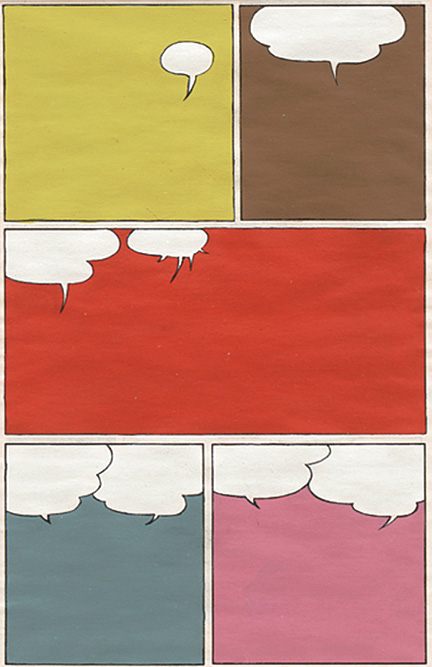 Roy Lichtenstein, and Pop artists in general, use a vocabulary which is both very culturally dependent but very universal within that frame. Bombshells (of both the exploding and blonde types), brooding dudes, primaries and flesh tones, halftone patterns, melodrama and speech bubbles are used... I don't really want to talk about him as critiquing the art world, mass entertainment and so on. Instead, I'm going to focus on my favorite element, the speech bubble and text. I imagine what the images would be without the contextualizing words; the inner turmoils and angst become externalized and smack ya. Text in artwork is a kind of funny paradox; it conveys more complex and subtle emotions but in a very direct way. Speech bubbles have a great, specific purpose, and when are put in different context do crazy things. Rivane Neuenschwander is an artist from Brazil who removed the context of a nationalistic Brazilian comic strip from the speech bubbles, leaving abstracted forms and colors. Text that is meant to be read as coming from some entity within a piece of art is a lot more interesting; there are implications of what the artist knows versus what the character knows versus what the viewer knows.
Roy Lichtenstein, and Pop artists in general, use a vocabulary which is both very culturally dependent but very universal within that frame. Bombshells (of both the exploding and blonde types), brooding dudes, primaries and flesh tones, halftone patterns, melodrama and speech bubbles are used... I don't really want to talk about him as critiquing the art world, mass entertainment and so on. Instead, I'm going to focus on my favorite element, the speech bubble and text. I imagine what the images would be without the contextualizing words; the inner turmoils and angst become externalized and smack ya. Text in artwork is a kind of funny paradox; it conveys more complex and subtle emotions but in a very direct way. Speech bubbles have a great, specific purpose, and when are put in different context do crazy things. Rivane Neuenschwander is an artist from Brazil who removed the context of a nationalistic Brazilian comic strip from the speech bubbles, leaving abstracted forms and colors. Text that is meant to be read as coming from some entity within a piece of art is a lot more interesting; there are implications of what the artist knows versus what the character knows versus what the viewer knows.
Top: "Ohhh... Alright" by Roy Lichtenstein, 1964. From a blog called the Swipe Files, which looks at similarities between elements in cartoons, comics and graphic novels through the issue of plagiarism, homage and reappropriation.
Left: "Zé Carioca no. 4, A Volta de Zé Carioca [The Return of Zé Carioca] (1960)" by Rivane Neuenschwander, 2004. From an article in This Week in New York.

